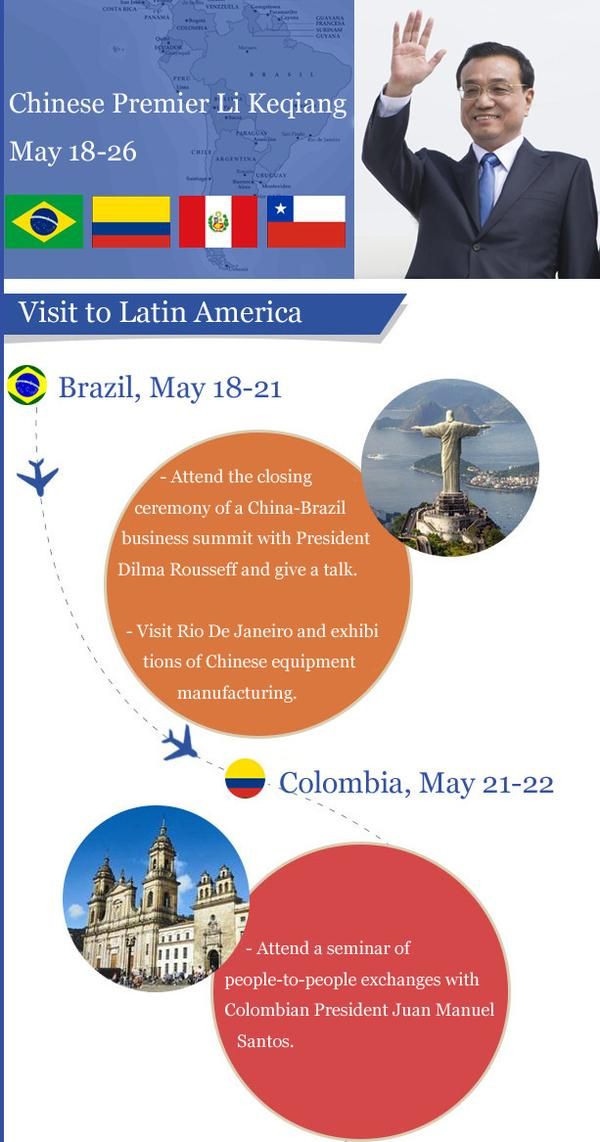Li's visit to boost ties with Latin America
By Yuan Dongzhen (China Daily) Updated: 2015-05-18 08:00

Premier Li Keqiang has embarked on a visit to Brazil, Colombia, Peru and Chile from May 18 to 26 and will push forward China's diplomatic efforts to strengthen ties with the region. The premier will seek to deepen cooperation with constructive partnerships with Latin American countries during his four-nation visit.
China's new Latin America policy embedded in Li's keynote speeches in the four countries should strengthen the China-Latin America comprehensive cooperative partnership - which the countries reached during President Xi Jinping's visit to the region in July last year.
During his visit to Brazil, Argentina, Venezuela and Cuba, President Xi proposed forging a community with shared destiny in which China and Latin American countries could enjoy mutual trust, regular trade and cultural exchanges, and close coordination in international affairs. Following that, the first ministerial meeting of the forum between China and the Community of Latin American and Caribbean States was held in Beijing in January, marking a breakthrough in overall cooperation between China and the region.
Similarly, Li is expected to boost the political momentum by restructuring China's resource-oriented economic exchanges with the Caribbean and Latin American countries. In particular, during bilateral discussion, Li is expected to highlight the scope of industrial and technical cooperation, and working together on infrastructure, free trade zones, training programs and financial support.
Also, to encourage Chinese enterprises and equipment makers to "go global" and cooperate with their Latin American counterparts, Li is likely to address Chinese and Brazilian businesspeople in Brasilia, Brazil's capital, and attend an exhibition of Chinese equipment in Rio de Janeiro, former capital of the country.
The feasibility study of the Twin Ocean Railroad Connection project that links the Pacific coast in Peru to Brazil's Atlantic coast, is also on Li's agenda. The trilateral project, jointly announced by China, Brazil and Peru last year during Xi's visit to the region, is expected to significantly increase the shipments of Brazilian resources such as ore and soy to Asia.
Moreover, Li's visit to Latin America is set to witness the signing of a variety of cultural exchange agreements between China and the four countries on his itinerary. The agreements, ranging from culture and education to special training programs, will play a supplementary role in the China-Latin America partnership.
It is worth noting that mutual interests and reciprocity - not Beijing's intention of "wrestling" with Washington or "looting" resources, as some Westerners say - remain the core driver of cooperation between China and the Latin American countries. In other words, the Chinese and Latin American economies are highly complementary to each other, which requires their governments to work closely. This is especially important at a time when China is entering an economic "new normal" and Latin America is grappling with economic downturn.
More importantly, China-Latin America relations will keep developing on the basis of mutual respect, inclusiveness and non-interference in the internal affairs of each other, which is to say China-Latin America cooperation will not affect their relations with other countries.
As a large consumer of energy, minerals and grains, which Latin America can provide, China is more than capable of helping the Latin American economies in infrastructure construction, especially after the global support it got for establishing the Asian Infrastructure Investment Bank and for its "Belt and Road Initiatives".
Although not covering Latin America, Beijing's "Belt and Road Initiatives" can serve as an example of transnational cooperation for China's Latin America policy, and thus benefit future exchanges.
The author is a researcher with the Institution of Latin American Studies, affiliated to the Chinese Academy of Social Sciences.

I’ve lived in China for quite a considerable time including my graduate school years, travelled and worked in a few cities and still choose my destination taking into consideration the density of smog or PM2.5 particulate matter in the region.











